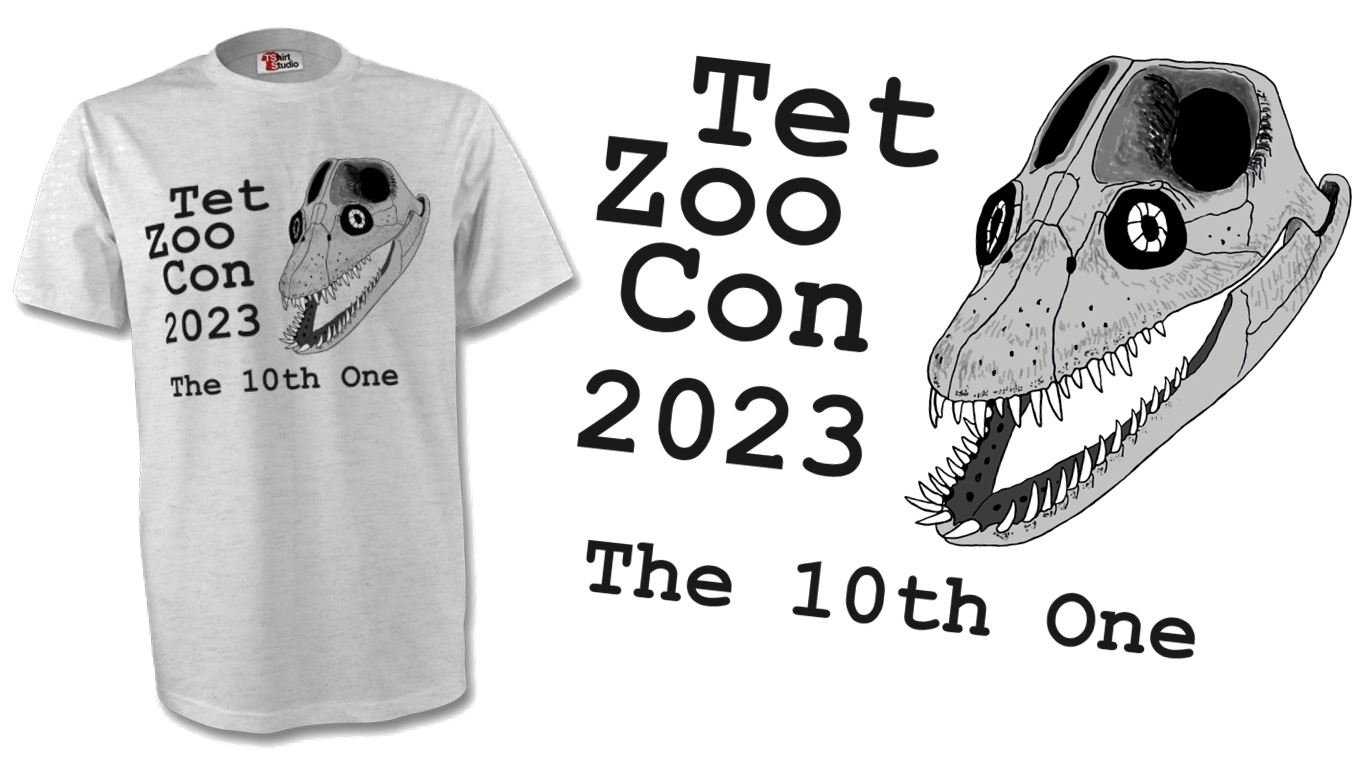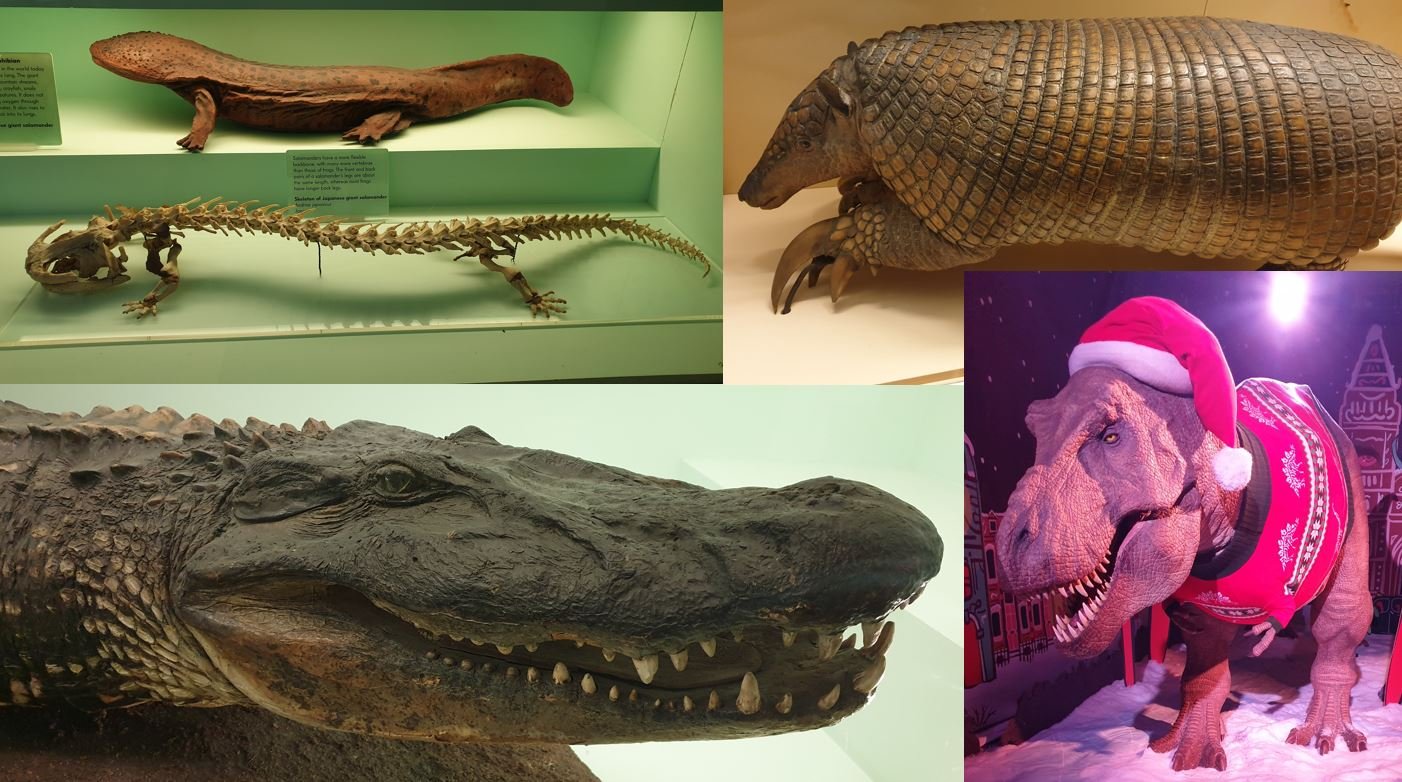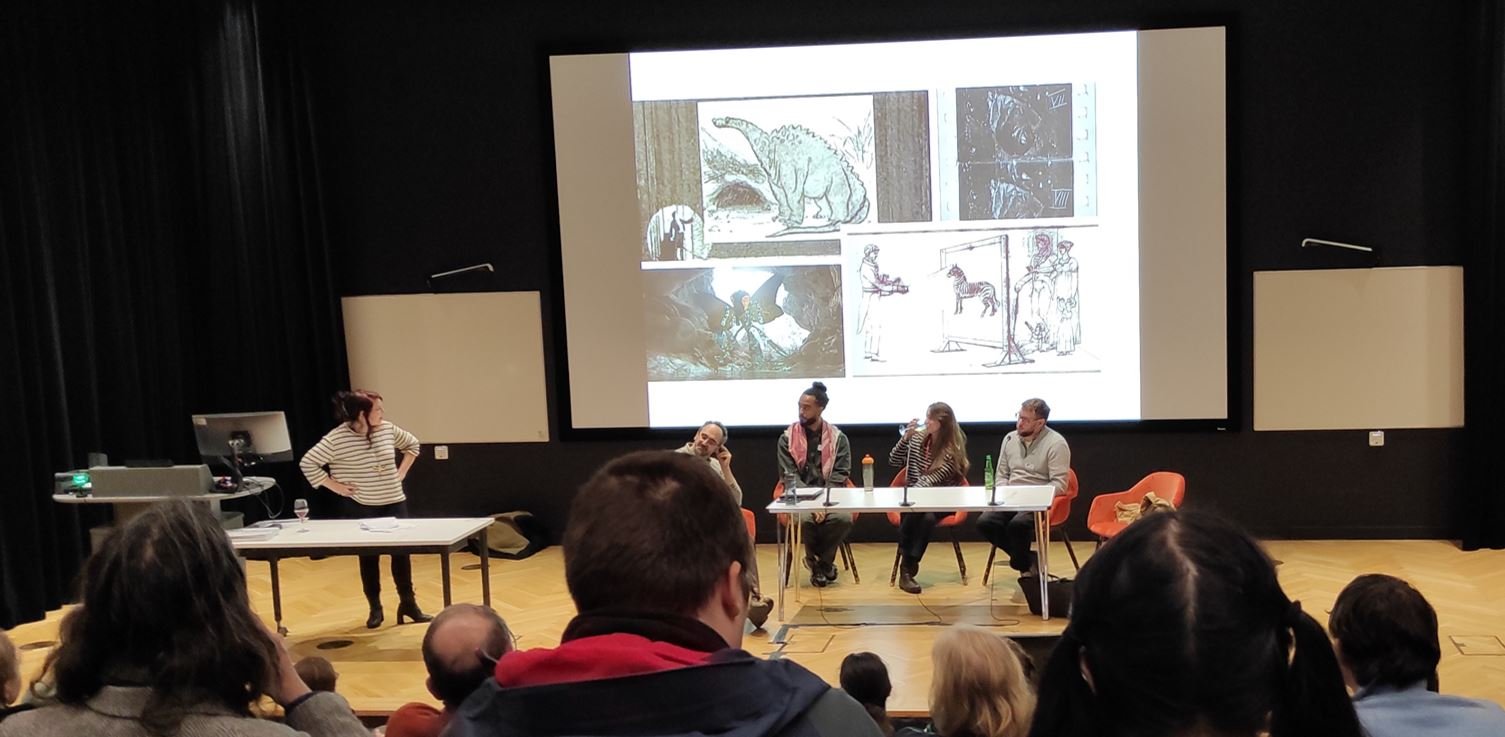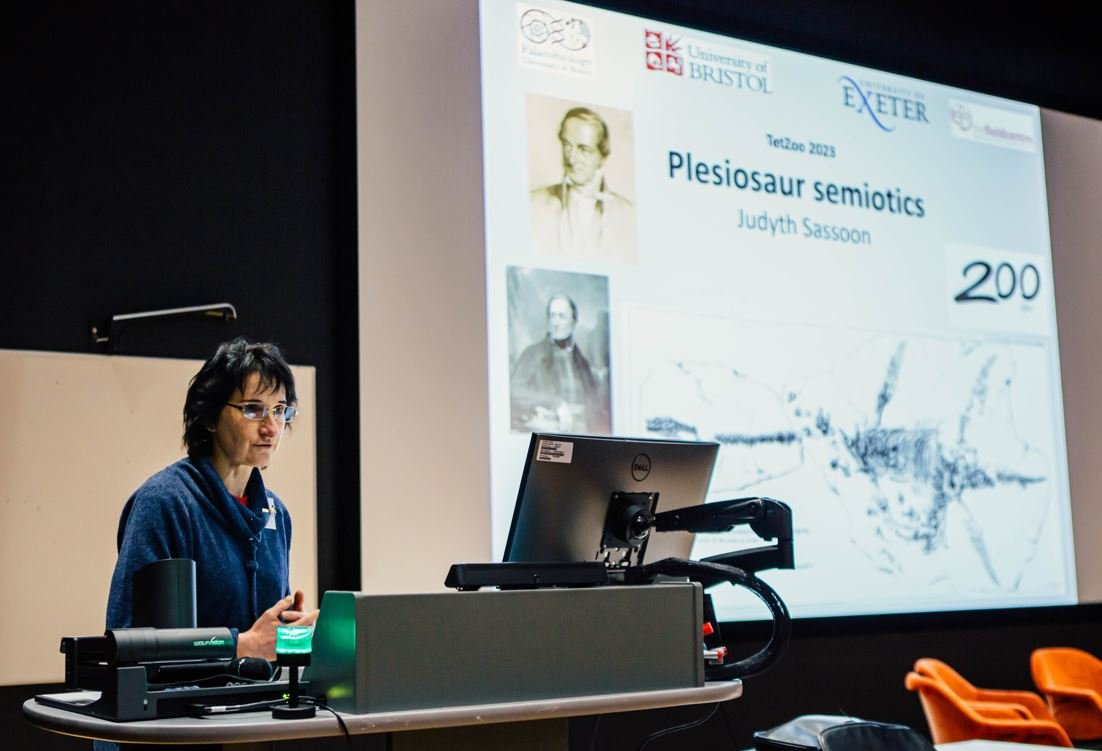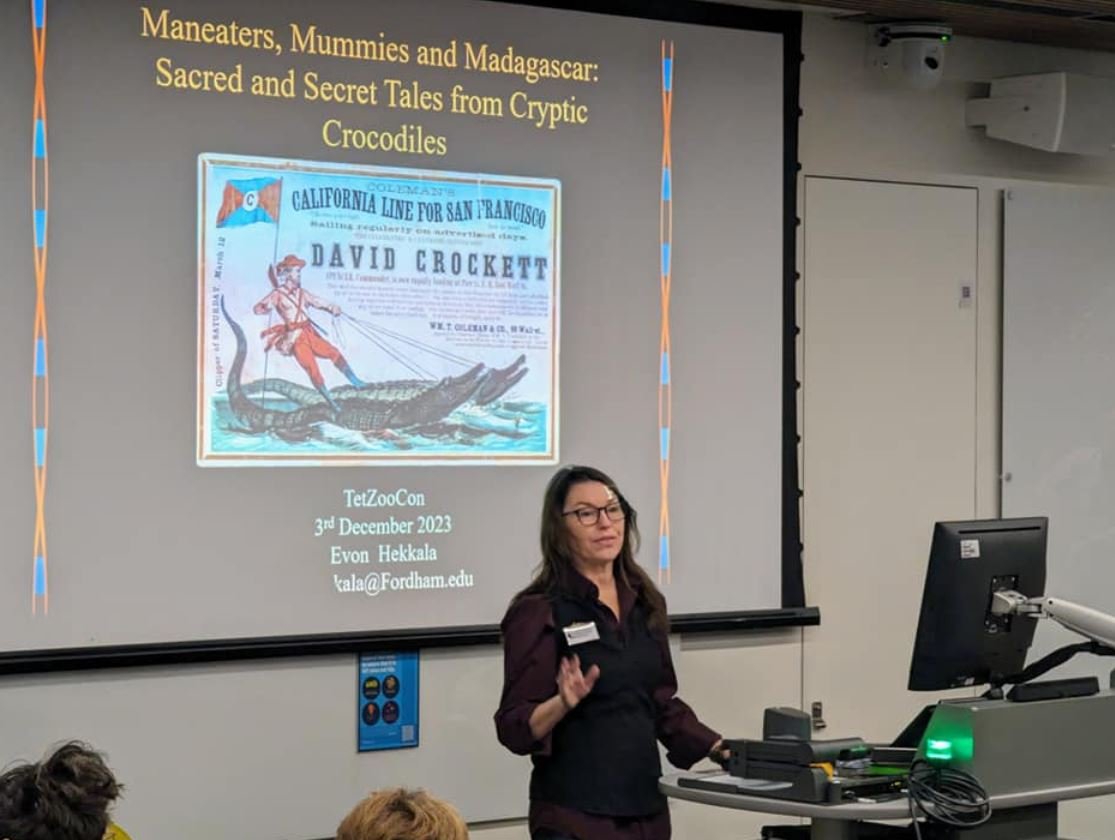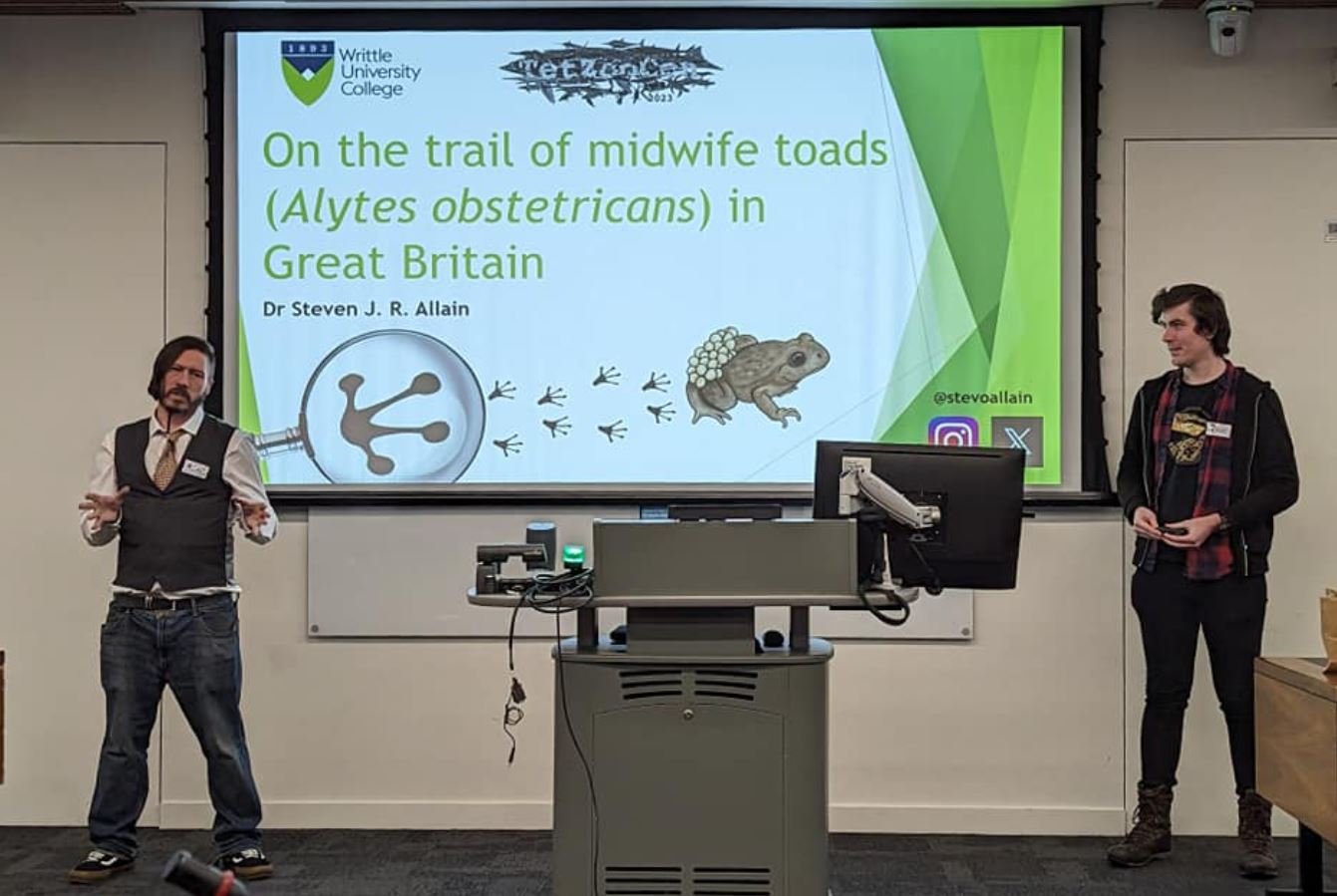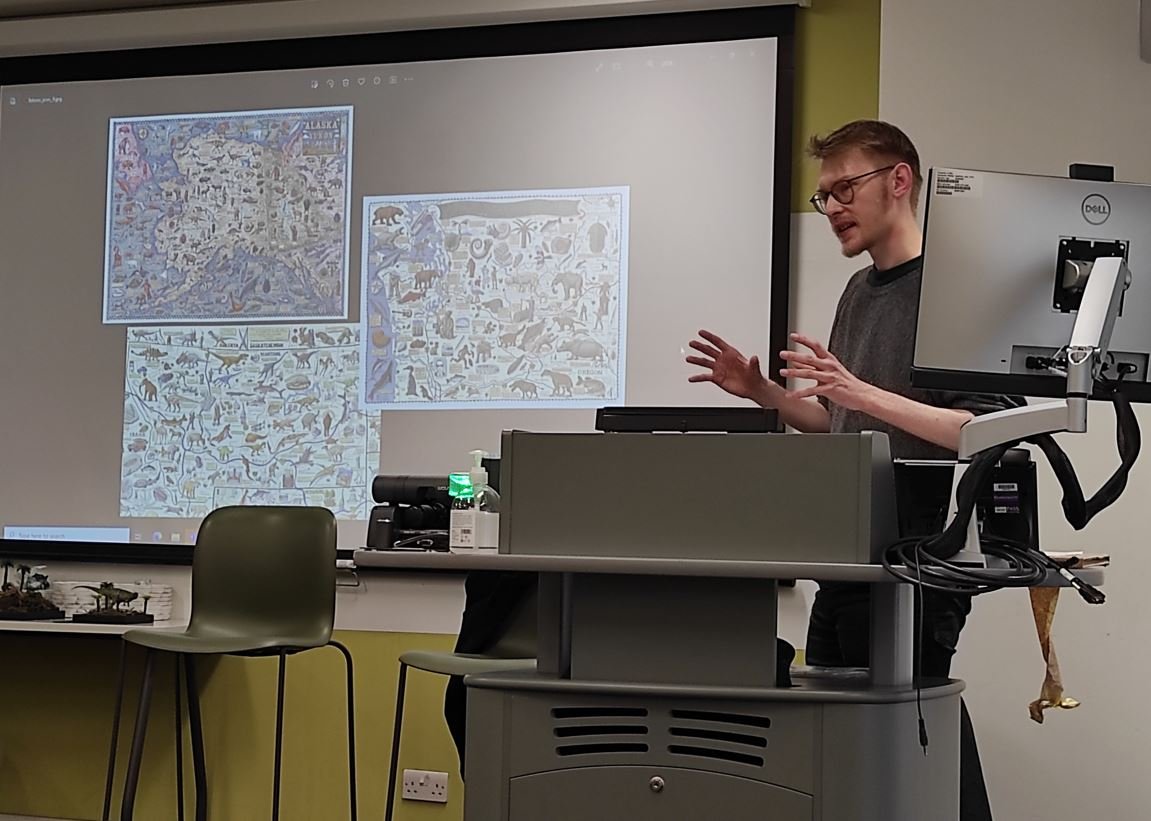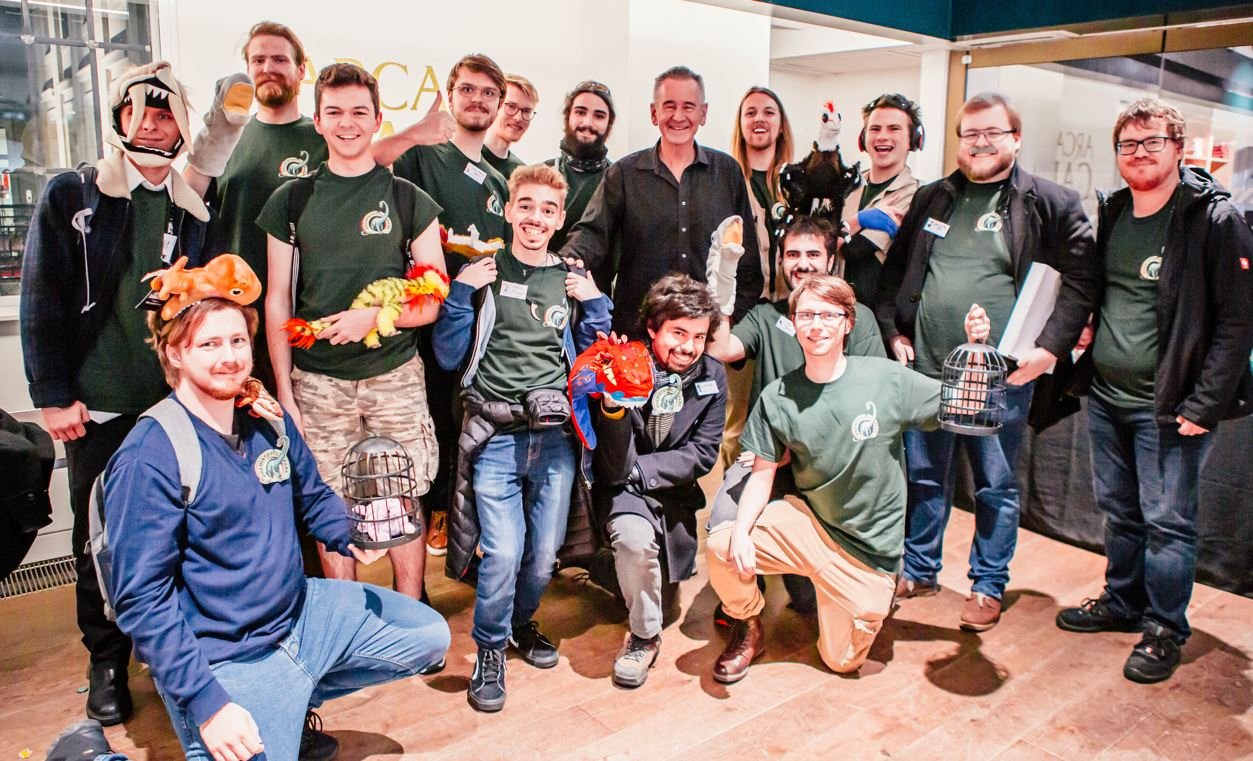The tenth TetZooCon – that’s the Tetrapod Zoology Convention – happened between Friday December 1st and Monday December 4th, and I think I’ve just about recovered. Hosted once again at Bush House, King’s College London (KCL), it was the biggest, busiest and most successful of our events so far, as is fitting for the tenth one…
Caption: the TetZooCon 2023 banner, composed of Mesozoic marine reptiles but a good number of additional animals too. Image: George Lathouris, used with permission.
Getting Bush House as a venue is big deal and we owe massive thanks to Chris Manias of KCL for helping to set it all up. It means that we have access to a massive auditorium, two or three upstairs rooms for workshops and breakout events, and a large foyer where we have stalls, a reception area that can be used for drinks, and an exhibition space. Chris’s involvement also means that we’re running in co-operation with the Popularizing Palaeontology network that he organises, and a consequence is that we now host a greater diversity of events than we might without him. This year, these included the panel event ‘Engaging with Extinctions – Past, Present and Future’ on the evening of the Friday, and a lunchtime screening of 1925’s The Lost World on the Sunday, introduced by Dave Hone.
Caption: TetZooCon 2023 merch! Buy it here.
Before I launch into more specific thoughts, let me say a massive thank you to our speakers, participants, vendors and assistants, without which none of this would happen. Thanks also to those who took photos and shared them, or allowed use of their photos here. Thanks in particular to professional photographer Alfred Barwick.
Caption: a montage of animals… all archosaurs… specially relevant to TetZooCon 2023. Left to right: Northern cassowary Casuarius unappendiculatus, American crow Corvus brachyrhynchos, the recently extinct Madagascan croc Voay robustus (art by Alex Lovegrove), and an assortment of captive Nile crocodiles Crocodylus niloticus (I think with a single Sacred crocodile C. suchus in there somewhere). Images: Darren Naish; (c) Alex Lovegrove.
The extinction panel event. And thus it was that, after spending the better part of Friday at the Natural History Museum with my daughter Hel and my friend Aidan Williams Dale (visiting from Canada, specifically for TetZooCon), we made the trek to Bush House. There were drinks, there was the setting up of stalls and such ahead of Saturday, and then there was the panel event.
Caption: a short pre-TetZooCon trip to the Natural History Museum involved us looking at Hope the Blue whale (at left) and posing with the Darwin statue. Darren Naish at left, Aidan Williams Dale at right.
Caption: some Natural History Museum trip highlights. Clockwise from upper left: giant salamander model and skeleton, Giant armadillo Priodontes maximus taxiderm specimen, T. rex animatronic in festive attire, Black caiman Melanosuchus niger in the Reptiles and Amphibians gallery. Images: Darren Naish.
The panelists (Aidan and myself, memory studies researcher Clara De Massol De Rebetz and artist and cultural geographer Amy Cutler) introduced ourselves before discussing the various extinction-related points introduced by Chris. I used my introduction to cover two of my favourite points relating to extinction: (1) that all extinctions start out as local extinctions, and that the tree removal, plastic pollution, degradation of local green space via over-use from people and their pet dogs, roadkill of animals large and small and so on is all part of the bigger, global problem. Extinction is not some remote thing happening only in Amazonia, Indonesia or Madagascar. (2) Long-extinct animals – looking mostly at you, non-bird Dinosauria – are essential tools for science literacy, and we shouldn’t be ashamed to use them in getting people interested in topics like ecology, evolution and extinction. Readers with good memories might recall that that second point was the main focus of my United National Science Summit presentation of September 2022.
Caption: I think the contents of this slide speak for themselves. All about me I see plastic pollution, road-killed animals large and small, and the constant removal of trees. Images: Darren Naish.
In the discussion that followed our opening pitches, we covered various points relating to how extinction is reflected in our work, projects and outlook. I’m strangely proud of the fact that I managed to incorporate a quote by the great Stewart Lee, make of that what you will. Amy Cutler turned up very late – I don’t want to embarrass her too much by saying why (though I will say that she went to the wrong venue) – but she delivered, her time culminating with the showing of a short film generated by an AI.
Caption: another scene from the Friday evening extinction panel, here showing Amy Cutler talking about visual representations of dead animals in film and how this relates to our understanding of extinction. Image: George Lathouris, used with permission.
At this point I have to mention the fact that the main auditorium wasn’t functioning properly. Last year, this same room overheated when kept in use for the better part of the day, and our timetable for 2023 was built around us leaving it empty for hours at a time in order to counter this. But fate is a cruel mistress, and this year a very opposite problem existed. The main auditorium was perpetually freezing cold, with no heating and cold air blasting in from the ventilation. I went on stage without a coat and succeeded, via violent thermogenesis, in burning off a fair amount of the spare calories I carry around.
We did what we could to get this fixed – numerous visits were made to KCL staff and numerous phonecalls happened – but all to no avail. A similar problem affected the foyer. This situation was such a farce that few people in attendance will forget it. But I hope that the quality and number of our talks and events and the good social vibe means that they might.
A marine reptile symposium. TetZooCon 2023 was partly based around Mesozoic marine reptiles, and this is because 2023 was the year in which I published Ancient Sea Reptiles (Naish 2022) [UPDATE: actually, the book saw print in 2022. But 2023 was the year in which it went on sale in shops and other outlets]. I spoke about fossil marine reptiles in general and was joined in the same session by Judyth Sassoon on plesiosaur semiotics (semiotics = nothing to do with partly formed ear regions but instead the topic of how meaning is conveyed via imagery) and Emily Swaby on temnodontosaurs, one of my favourite ichthyosaur groups.
Caption: Judyth Sassoon in the marine reptiles session, her opening slide visible in the background. Image: Alfred Barwick, used with permission.
Later in the day, Dean Lomax discussed the story behind the Rutland Sea Dragon, a spectacular British ichthyosaur – a temnodontosaur no less – still under study (one paper on the specimen has recently appeared: Larkin et al. 2023). Dean has also been involved in the recently completed movie Why Dinosaurs? which just had its Hollywood premiere, so we were also treated to a showing of the trailer. This was followed by a marine reptile panel event in which I was joined on stage by Emily, Dean and Luke Muscutt (the other marine reptile speakers had other engagements). Topics discussed included our inspirations and the people who’d aided and assisted us early on (I slipped a tenner to Luke, who then explained how his primary scientific role model was that Darren Naish guy), our thoughts on what other researchers might have gotten wrong, and what we’re doing next on the subject.
Caption: Dean Lomax talks at TetZooCon 2023 on the Rutland ichthyosaur, quite fairly bigged up as the most spectacular ichthyosaur specimen yet discovered in the UK. Infamously dubbed the ‘sea dragon dinosaur dolphin’ by a British journalist, it represents an animal that would have been around 10 m long. Image: Darren Naish.
Caption: the marine reptile discussion panel, showing (l to r) Darren Naish, Luke Muscutt, Emily Swaby and Dean Lomax. Yes, I appreciate the irony of the backdrop being some fish-themed montages. Image: Alfred Barwick, used with permission.
A planned proper book signing for Ancient Sea Reptiles never happened as I couldn’t make time for it, but I sold my entire stock anyway and now need more. I also sold all the copies I brought of Dinosaurs: How They Lived and Evolved (the new third edition) and nearly all my stock of Dinopedia too.
In a separate marine reptile session on Sunday, Luke spoke about Flip, the world’s first realistic plesiosaur robot. Flip was in attendance and those present were allowed to see it in action (and even, in special cases, operate it themselves). This event was filmed and some of this material will appear in a documentary. UPDATE: part of the TetZooCon 2023 outing of Flip has been released on YouTube.
Caption: Luke Muscutt (standing at left) discusses his work on Flip, the robot plesiosaur that had its first public outing at TetZooCon. Flip stars in the BBC documentary Attenborough and the Giant Sea Monster, to be screened on BBC One on New Years’ Day 2024. So does Luke! Image: Alfred Barwick, used with permission.
In the same session, Richard Forrest spoke about his experiences with the excavation of plesiosaur fossils. I missed both of these talks due to the modern archosaur session happening at the same time. Ah yes, that…
The modern archosaur session. Said aforementioned modern archosaur session involved Jennifer Campbell-Smith on corvids and fieldwork on them, Todd Green on cassowaries, a cassowary discussion panel, and Evon Hekkala on crocodiles. Quite the lineup. But while we were setting things up the entire electrical box at the lectern – supplying power to the computers, microphones and everything else there – died. We did everything we could to see if this could be fixed (it was most likely a blown fuse) and sought help from staff… but this too was all for nothing. And thus we had to resort to jumping from room to room, which was partly a relief given the low temperatures caused by the heating/ventilation problem. I won’t explain the fully sorry saga as it’s long-winded and embarrassing, but it was a total shambles and we ended up moving three times. Having said all that, the talks still happened, and they were great.
Caption: Todd Green talks cassowaries. I worked with Todd and his team in Florida to relocate several adult cassowaries in early 2023: here’s the Tetrapod Zoology article on that event. To learn more about the cassowary-themed movie Todd and colleagues are currently putting together, go here. Image: Georgia Witton-Maclean, used with permission.
Jenn’s corvid talk was a highlight for many people. She discussed crow diversity in general, and her own fieldwork on American crows and how they transfer and learn information. Jenn is an amazing artist and (like so many who attend TetZooCon) an outstanding natural historian, and it was an honour to have her join us. Next up was Todd who gave a rundown on cassowary research and where we’re at with respect to our knowledge today. Todd and colleagues (namely Kerrie and AJ Dodd, both present at TetZooCon 2023 as well) are making a film (you can help support it here) and his talk was followed by a panel event in which I, Todd and AJ – chaired by Jenn – discussed cassowaries some more. Todd, AJ and Kerrie also had a stall where they sold and auctioned cassowary-themed objects including a model head and 3D-printed foot.
Caption: Jennifer Campbell-Smith talks corvids. I’m going to steal some of Jenn’s own words on TetZooCon 2023: “It was an utterly delightful mix of professional and enthusiast zoology nerds who could all come together to discuss and enjoy our passions in a welcoming, safe, fun environment. The sincere interest in my talk and both the compliments and excellent conversation I received afterward were humbling, heart-warming, and genuinely had a deep impact on me”. Image: Todd Green.
The final talk of the session was Evon Hekkala’s on ‘Maneaters, Mummies and Madagascar; Sacred and Secret Tales from Cryptic Crocodiles’. This was another highlight; it covered Evon’s research on the crocodiles of both mainland Africa and Madagascar, and discussed this work within the broader context of her research and career.
Caption: Evon Hekkala on her crocodile research. This has involved the resurrection of Crocodylus suchus as distinct from C. niloticus, the recovery of new specimens of the recently extinct Voay and its phylogenetic position, and more. An amazing talk. Image: Georgia Witton-Maclean, used with permission.
Additional talks that weren't part of these ‘themed’ sessions happened too. Herpetologist Steve Allain spoke about his research on the non-native midwife toads living in England (e.g., Allain et al. 2019a, b, Allain & Shimbov 2021), Hanna Ayoob spoke about her work in running zoology-themed outreach and scicomm events, and Amber Coste discussed her studies of extinct dolphins from New Zealand, notable for their remarkably odd and sometimes tusk-like protruding teeth (Coste et al. 2023a, b). Amber was a PhD student of fossil marine mammal specialist Ewan Fordyce who, sadly, died this year, so it’s fitting that her talk was dedicated to him.
Caption: Steve Allain (at right) is introduced by James Pascoe. One of several talks I really wanted to see but couldn’t get to, alas. Image: Georgia Witton-Maclean, used with permission.
Caption: Amber Coste talks weird fossil dolphins, but at this point of the talk is discussing the contributions of her PhD supervisor, the late Ewan Fordyce. Image: Alfred Barwick, used with permission.
Caption: more Amber. Her talk featured a good amount of interesting, and sometimes necessarily speculative, palaeoart. Image: Georgia Witton-Maclean, used with permission.
An eternal winter of palaeoart. Palaeoart is a mainstay of TetZooCon and we’ve always had a palaeoart workshop of some sort, usually accompanied by one or more exhibitions. This year we decided to ramp things up and basically have palaeoart events running for most of the wekend. John Conway engaged Luis Rey in a discussion on Luis and his work, and Joschua Knüppe led a show-and-tell (whereby numerous artists spoke about their projects).
Caption: Luis Rey (at left) discusses his palaeoart work with John Conway. Those numerous small boxes in the background contain small, pliosaur-shaped objects used in a workshop event that occurred later on the same day. Image: Alfred Barwick, used with permission.
Caption: Joschua Knüppe explains the background to his palaeo-map project, here showing efforts that have gone beforehand (specifically, maps produced by Ray Troll). Image: George Lathouris, used with permission.
James Pascoe led a paint-a-pliosaur event in which a pre-booked number of people decorated a TetZooCon exclusive pliosaur model. I wasn’t able to attend any of this due to my presence in other sessions and was especially worried about not getting to claim ownership of a patented Pascoe pliosaur. But I needn’t have worried, because….
Caption: a very large Pascoe pliosaur (it’s 46 cm long) has joined the Tet Zoo Towers collection, and I am pleased. Image: Darren Naish.
James also brought along several wonderful dioramas depicting Mesozoic dinosaurs in miniature landscapes, though quite how he transported these without them getting smashed to bits still amazes me. Also within the palaeoart event, I led a Prehistoric Planet discussion, which again was only available to a limited number of attendees due to room size.
Caption: some of (or parts of some of) the very impressive Jurassic and Cretaceous dioramas created by James Pascoe, available on show at TetZooCon 2023. James notes Paul Glynn as among his inspirations, and Paul has showcased his own dioramas at TetZooCon in the past. Image: George Lathouris, used with permission.
Sales and stalls. The main foyer of the venue was fully occupied by stalls and tables. We’ve been hosting more and more of these year on year as TetZooCon has grown, and this year were at maximum capacity, with as many tables as we could get. On that note, I never had time to look properly at all the stalls, let alone buy anything from them. Everything was amazing and exciting, from Rebecca Groom’s palaeoplushies to Steve White’s art prints, to the range of models and figures made by Sam St Leger, Paul Glynn and others, and to the stickers, cards and more offered by others. I sold books and various animal figures, as well as a range of TetZooCon merchandise, including cups, t-shirts and tote bags (all of which, and more, are available here). Dougal Dixon was in attendance again and also shifted a good number of books.
Caption: a palaeoplushie-themed table, hosted by Leo Chilvers (at left) and Rebecca Groom. Note the size of some of the pieces for sale here (visible at far right). Also worth looking for is the Prehistoric Planet-style Mononykus (sitting in the cardboard popcorn box) next to Leo. Image: Georgia Witton-Maclean, used with permission.
Caption: I’ve mentioned a few times here the range of All Yesterdays figures produced by Sam St Leger of Splendid Editions. See below for close-ups of the figures Sam has produced so far (more are on the way). When taking this photo I inadvertently photographed Natalia Jagielska presenting her super-floofy Sinosauropteryx plushie as if it might be the second coming of Christ. Image: Darren Naish.
Caption: more detailed views of Sam St Leger’s All Yesterday’s figures, with other figures visible too (including Moschops and a Tarasque). These are available from the Splendid Edition shop on Etsy. Image: Darren Naish.
Several things were on sale at TetZooCon 2023 as exclusives, or for the first time ever. Perhaps most notable among these were the scale Velociraptor statues made by Jed Taylor and Ruadhrí Brennan. These are models of superb and frightening craftmanship, and – as is appropriate – they aren’t cheap. In view of this, I had a mild concern that they might not sell. They sold out within the first 20 minutes of the Saturday.
Caption: scenes from the Jed Taylor and Ruadhrí Brennan stall… argh, such treasures! I sincerely planned to at least buy some fridge magnets (those numerous skull models on the dark plate) but didn’t even get round to that. Hopefully Jed and Ru will be selling wares at future events, and if that’s not a draw I don’t know what is. Images: Ruadhrí Brennan.
Caption: each of those little orange slips next to a Taylor-Brennan Velociraptor figure says SOLD. In the end, even the giant one at far left was purchased as well. I planned to get the whole set for my own collection but…. yeah, that didn’t exactly work out as planned. Image: Jed Taylor.
As might be obvious to those who were there, let me say again that we’re basically at maximum capacity in terms of what can fit in the foyer. That’s a bit of a problem, since our plan is to expand and host more stalls. I’m not yet sure how we’re going to get round that for 2024 and beyond – stay tuned.
Caption: one of so many excellent art-themed stalls we had at TetZooCon 2023. This is Lee Brown’s; Lee runs DailyDinoSketch and sells art, stickers, rock art and more here at Etsy. Image: George Lathouris, used with permission.
Caption: another stall, this time run by Emily Higgs. Stickers, prints and tons more! The Emily Higgs Shop is here on Redbubble. Image: Georgia Witton-Maclean, used with permission.
Caption: I had to deliberately avoid looking at this stall for too long or my finances would look bleaker than they already do. This is Paul Glynn’s range of figures and models, and oh my god. I love those Wealden dinosaur models, but the sharks and pike very much have my full attention as well. Paul’s work is available on Etsy at TheYoungerEarth. Image: George Lathouris, used with permission.
Cosplay! If you remember the article on TetZooCon 2022, you might recall the mention of the impromptu cosplay event that happened there, entirely thanks to the good work of palaeontology Phd student Meghan Jenkinson. I’ve been thinking for years of hosting cosplay at TetZooCon. After all, we’re always joined by an incredibly talented, creative number of individuals whose skills and interests are very much relevant to cosplay. And thus TetZooCon 2023 hosted a cosplay competition, led by Meghan and Hel Naish.
Caption: the cosplay event, with Meghan (in hazmat suit) and Hel (with giant tail) present at far left. Image: Alfred Barwick, used with permission.
A good number of attendees made an effort, the three winners being Connor Temple from Primeval (played by Armin Reindl), Mary Anning (played by Mélissa Delteil) and Nigel Marven (played by James Appleby). Prizes included those kindly provided by our friends at Everything Dinosaur and Palaeoplushies.
The Marven Event, and the quiz. I’ve been trying for a while to book film-maker, writer, TV presenter and natural historian Nigel Marven for TetZooCon, and I’m pleased to say that Nigel’s busy schedule finally allowed this to be fulfilled this year. The broken nature of the main auditorium meant that we had to run his talk in an upstairs room not nearly as big, so it was totally overcrowded. Nigel spoke about his involvement in those TV shows depicting prehistoric animals – Prehistoric Park, Primeval and the Walking With specials – as well as his various adventures with living reptiles, his recent film-making projects in Slovakia and elsewhere, and more. He was good enough to hang around for signings, photos with the fans and so on and here’s where it became obvious that a good number of our attendees – I believe they call themselves the palaeostream team – were all wearing specially made Prehistoric Park t-shirts.
Caption: we were very pleased to have Nigel Marven speaking at TetZooCon 2023, and here he is with his cover slide in the background. Image: Alfred Barwick, used with permission.
Caption: a packed-out lecture room during Nigel’s talk (too packed-out; but we were meant to be in the giant main auditorium, alas). Image: Alfred Barwick, used with permission.
Caption: Nigel Marven (in the middle) surrounded by a happy throng of Palaeostream friends, plus various Mesozoic-themed props. Image: Alfred Barwick, used with permission.
Occurring in parallel to the Marven Event – apologies to those who wanted to do both – was our quiz. Richard Hing was the winner this year, with Kelvin Britton and Albert Chen being runner-ups. Prizes were kind donations from various of our vendors and also Everything Dinosaur: thank you all so very, very much. And thus things drew to a close…
Fieldtrip! Except they didn’t, because a good number of us – around 40 – went to London Zoo on the Monday. Despite the potential for bad weather, it turned out all right and was a success. We looked at interesting aspects of the zoo’s historical architecture – I always enjoy telling people about the stories behind the Elephant and Rhino House (now the Casson Pavilion), the Goat Hills of the Mappin Terraces and more – and we were lucky with the animals.
Caption: the TetZooCon 2023 fieldtrip contingent in the walk-through aviary. Numerous Scarlet ibis Eudocimus ruber are visible, as is a lone Abdim’s stork Ciconia abdimii on the roof at upper right. As discussed below, we’ll be making the fieldtrips (which have been a constant TetZooCon feature since the first one) a more integrated thing from 2024. Image: Darren Naish.
Highlights included Western gorillas Gorilla gorilla having sex, a vicious attack on my good self by a juvenile Scarlet ibis, a very close-up view of one of the Linne’s two-toed sloths Choloepus didactyla, eye contact with a Chinese muntjac Muntiacus reevesi, and brief viewings of an aye-aye Daubentonia madagascariensis. We also had excellent views of two young Sumatran tigers Panthera tigris sondaica playing and even carrying sticks and small logs around.
Caption: a London Zoo montage, showing (clockwise from upper left) co-operative Chinese muntjac, a slightly blurry Mohol bushbaby Galago moholi, and a detail of the stonework around the entrance of the (now closed) Reptile House, showing a parent Shingleback skink Tiliqua rugosa with its babies (these lizards have extended parental bonds, and it’s interesting to see that this was known during the 1920s, the time when the Reptile House was built). Images: Darren Naish.
I’ll finish here by saying that the ad hoc, impromptu nature of the trip meant that we weren’t able to take advantage of anything intelligent like a group discount. That’s changing from 2024, on which read on.
To the future. TetZooCon 2023 was hard work. I, personally, have never been so rushed and overworked at any event, and it was bad enough that I was often unable to get time to eat or even drink. We were also let down by a cascade of failures at the venue that were beyond the control of any of us running TetZooCon, all of which makes it clear how bad universities are at catering to external events outside of normal hours. Nevertheless, it was enough of a success that we’re already thinking about plans for 2024. I can say to begin with that we will be in the same venue, will almost certainly be running things across a Friday evening and a weekend, and will again be hosting a fieldtrip of some sort (hold that thought).
Caption: I think it can be agreed that we have a pretty impressive selection of stalls at TetZooCon 2023. We only hope that this will continue into the future. The montage here shows (clockwise from upper left) images from the Neo Jurassica stall (the skeleton is that of the Brazilian noasaurid theropod Berthasaura); prints from Mark Witton; and replica skulls and models manufactured by Paul Glynn. Images: George Lathouris, used with permission.
A few things have to change though. We’ll be undergoing an upscaling of sorts, perhaps with a dedicated committee that betters handles and manages the event’s different components. We also have to become more expensive. I hope that people appreciate how cheap TetZooCon is compared to similar events (conventions and conferences), and the fact is that we’re not generating enough income to cover our outgoings. We’re currently considering making TetZooCon something bigger than a weekend-long event, on which stay tuned, and are also looking into turning the fieldtrip into a larger and more formalized thing. I’ve worked in the past as a tour guide and, yes, am thinking quite seriously about getting coach trips and maybe even overnight stays part of our remit. None of this is arranged yet but at least now you’ve been warned.
Caption: going to London Zoo and looking at Bactrian camels and excellent artwork is all well and good, but what about going further afield and looking at stuff way beyond the outskirts of the nation’s capital? We shall see. Images: Darren Naish.
At least part of TetZooCon 2024 will be devoted to cryptozoology, mostly because I hope to have another book out and published by then… yikes, no pressure. Other stuff will be happening as well though, and we’re also looking at booking special speakers on other subjects. For news watch the TetZooCon page at Facebook and #TetZooCon on Twitter/X and elsewhere.
It feels to me like we’ve reached another milestone in the history of this event, this tenth one being appropriately massive and well-attended. Indeed, the continuing success of TetZooCon demands that we have to change and upscale once again. It only remains for me to say a massive thanks to everyone who attended and made it what it was (big shout in particular to those who joined us from overseas, it was such a thrill to see you), to those who worked with me in running the whole thing, and to our speakers, stall holders and event-runners. See you again, I hope, in 2024.
Caption: the primary TetZooCon organizers, Darren Naish (left) and John Conway, with a Rebor American alligator in the middle. I really should have taken a holiday right away. But I couldn’t. Image: Hel Naish.
Other articles on TetZooCon 2023 will be listed here as and when they’re published. Steve Allain’s review is here.
For previous articles on TetZooMCon and TetZooCon, see…
The events of TetZooCon 2014, July 2014
TetZooCon 2015 Is On, July 2015
The Events of TetZooCon 2015, November 2015
Coming Soon: TetZooCon 2016, September 2016
The Day After TetZooCon, October 2016
The Fourth TetZooCon, September 2017
The TetZooCon of 2017, October 2017
Reasons to Attend TetZooCon 2018, September 2018
TetZooCon 2018: Best TetZooCon So Far, October 2018
Announcing TetZooCon 2019 – the Biggest Yet, August 2019
Final Call For TetZooCon 2019, October 2019
The Sixth TetZooCon, October 2019
TetZooCon 2020 + Zoom = TETZOOMCON 2020, December 2020
TetZooMCon 2020 an Unbridled Success, December 2020
Cronch Cats, Beasts of Gévaudan, Dinosauroids, Mesozoic Art and Much More: TetZooMCon 2021 in Review, September 2021
The Ninth and Largest of the Tetrapod Zoology Conventions, December 2022
Announcing the 10th Tetrapod Zoology Convention, October 2023
At TetZooCon 2023, November 2023
Refs - -
Allain, S., Gandola, R., Tighe, A. & Wilkinson, J. W. 2019a. An investigation into the provenance of Bedford’s midwife toads. Bedfordshire Naturalist 74 (1), 48-52.
Allain, S., Gandola, R. & Wilkinson, J. W. 2019b. One or multiple origins of Midwife toads in the UK? FrogLog 27 (1), 23.
Allain, S. & Shimbov, M. I. 2021. The mystery of the Thorney midwife toads (Alytes obstetricans). Nature in Cambridgeshire 63, 26-27.
Coste, A., Fordyce, R. E. & Loch, C. 2023a. A new dolphin with tusk-like teeth from the late Oligocene of New Zealand indicates evolution of novel feeding strategies. Proceedings of the Royal Society B: Biological Sciences 290 doi 10.1098/rspb.2023.0873
Coste, A., Fordyce, R. E. & Loch, C. 2023b. A new fossil dolphin with tusk-like teeth from New Zealand and an analysis of procumbent teeth in fossil cetaceans. Journal of the Royal Society of New Zealand doi 10.1080/03036758.2023.2267456
Larkin, N. R., Lomax, D. R., Evans, M., Nicholls, E., Dey, S., Boomer, I., Copestake, P., Bown, P., Riding, J. B., Withers, D. & Davis, J. 2023. Excavating the ‘Rutland Sea Dragon’: the largest ichthyosaur skeleton ever found in the UK (Whitby Mudstone Formation, Toarcian, Lower Jurassic). Proceedings of the Geologists’ Association 134, 627-640.
Naish, D. 2022. Ancient Sea Reptiles: Plesiosaurs, Ichthyosaurs, Mosasaurs & More. Natural History Museum Publishing, London.


